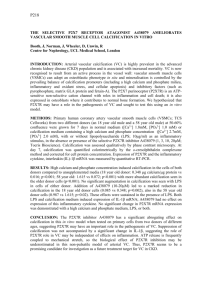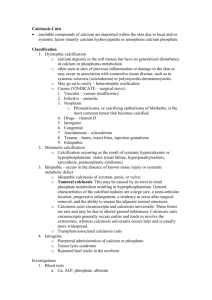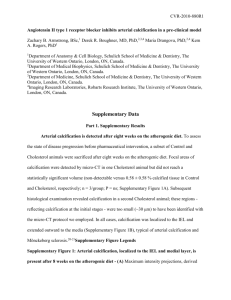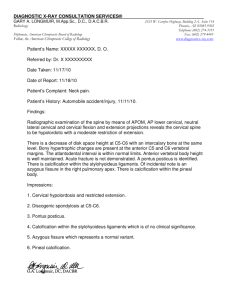Soft tissue calcifications
advertisement
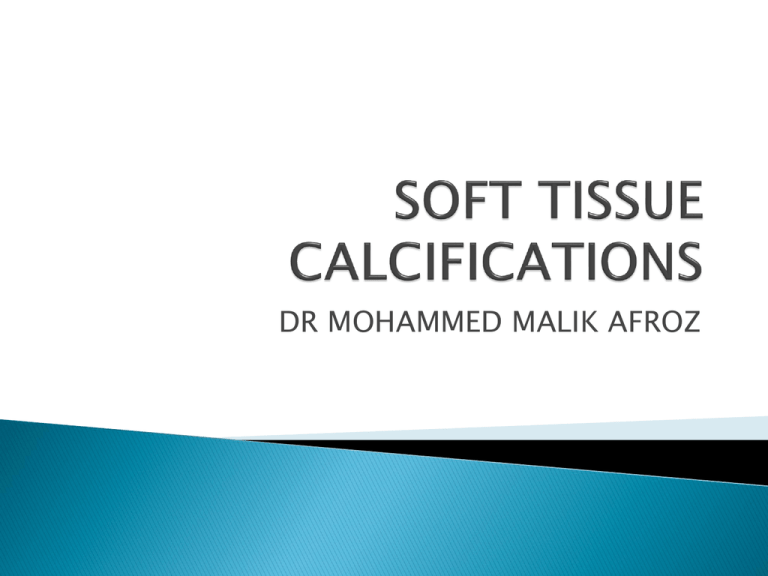
DR MOHAMMED MALIK AFROZ INTRODUCTION DYTROPHIC CALCIFICATIONS IDIOPATHIC CALCIFICATIONS METASTATIC CALCIFICATIONS Idiopathic calcification (or calcinosis) – results from deposition of calcium in normal tissue despite normal serum calcium and phosphate levels Metastatic calcification – results when minerals precipitate into normal tissue as a result of higher than normal serum levels of calcium (e.g., hyperparathyroidism, hypercalcemia of malignancy) or phosphate (e.g., chronic renal failure). Metastatic calcification usually occurs bilaterally and symmetrically When the mineral is deposited in soft tissue as organized, well-formed bone, the process is known as heterotropic(extra skeletal) ossification. The causes range from posttraumatic ossification, bone produced by tumors, and ossification caused by diseases such as progressive myositis ossificans and ankylosing spondylitis DEFINITION – precipitation of calcium salts into primary sites of chronic inflammation or dead and dying tissue despite normal serum calcium and phosphate levels. ETIOLOGY – The soft tissue may be damaged by blunt trauma, inflammation, injections, the presence of parasites. Process is usually associated with a high local concentration of phosphatase, as in normal bone calcification, an increase in local alkalinity(ph more than 7), and anoxic (loss of oxygen) conditions within the inactive or devitalized tissue. CLINICAL FEATURES – This calcification usually is localized to the site of injury like chronic cyst. No signs or symptoms but may show occasionally enlargement and ulceration of overlying soft tissues may occur, and a solid mass of calcium salts sometimes can be palpated. Calcified lymph nodes Calcification in tonsils Cysticercosis Arteriosclerosis varies from barely perceptible, fine grains of radiopacities to larger, irregular radiopaque particles that rarely exceed 0.5 cm in diameter. One or more of these radiopacities may be seen, and the calcification may be homogeneous or may contain punctate areas. The outline of the calcified area usually is irregular or indistinct. Lymohoid tissue is replaced by hydroxyapatite-like calcium salts nearly effacing all of nodal architecture ETIOLOGY – tuberculosis, BCG vaccination, sarcoidosis, cat-scratch disease, lymphomas, fungal infections, and metastases from distant calcifying neoplasms. CLINICAL FEATURES – discovered as an incidental finding on a panoramic radiograph. Most commonly involved nodes are submandibular and cervical nodes (superficial and deep) less commonly, the preauricular and submental nodes. When these nodes can be palpated, they are hard round or oblong masses Location – The most common location is the submandibular region, either at or below the inferior border of the mandible near the angle, or between the posterior border of the ramus and cervical spine. Calcification may affect a single node or a linear series of nodes as lymph node chaining PERIPHERY – The periphery is well defined and usually irregular, occasionally having a lobulated appearance similar to the outer shape of cauliflower. Internal Aspect – vary in the degree of radiopacity, giving the impression of a collection of spherical or irregular masses. Occasionally the lesion has a laminated appearance MANAGEMENT – treat underlying cause Tonsillar calculi are formed when repeated bouts (episodes) of inflammation enlarge the tonsillar crypts. Incomplete resolution of dead bacteria and pus serve as the nidus (cause)for dystrophic calcification. Clinical Features – hard, round, white or yellow objects projecting from the tonsillar crypts. pain, swelling, fetor orisdysphagia, and a foreign body sensation on swallowing have been reported with larger calcifications. LOCATION – In the panoramic film, tonsilloliths appear as single or multiple radiopacities that overlap the mid – portion of the mandibular ramus in the region where the image of the dorsal surface of the tongue crosses the ramus in the palatoglossal or glossopharyngeal air spaces PERIPHERY – The most common appearance of tonsilloliths is a cluster of multiple small, illdefined radiopacities. Rarely this calcification may attain a large size. Internal Structure – approximately same radiodensity as cortical bone. When humans ingest eggs or gravid proglottids from Taenia solium (pork tapeworm), the covering of the eggs is digested in the stomach and the larval form of the parasite is hatched. The larvae can enter any part of body but preferentially locate to brain, muscle, skin, and heart. CLINICAL FEATURES – Gastro – intestinal features like nausea, vomiting and stomach pain. Examination of the head and neck may disclose palpable, well-circumscribed soft fluctuant swellings, which resemble a mucocele. Radiographic Features – NOT SEEN RADIOGRAPHICALLY WHEN LARVAE ARE ALIVE Location – muscles of mastication and facial expression, the suprahyoid muscle, and the postcervical musculature Periphery and shape – Multiple, well-defined, elliptical radiopacities are viewed, resembling grains of rice. INTERNAL STRUCTURE – Uniformly radiopaque Two distinct patterns of arterial calcification can be identified both radiographically and histologically: 1. Monckeberg's medial calcinosis 2. calcified atherosclerotic plaque. DEFINITION – loss of elastic fibers followed by the deposition of calcium within the medial coat of the blood vessel. Clinical Features – initially asymptomatic but later may develop cutaneous (skin) gangrene, peripheral vascular disease and myositis due to vascular insufficiency. Patients with Sturge-Weber syndrome also develop intracranial arterial calcifications. LOCATION – Medial calcinosis involving the facial artery or, less commonly, the carotid artery, may be viewed on panoramic radiographs PERIPHERY AND SHAPE – From the side the calcified vessel appears as a parallel pair of thin radiopaque lines that may have a straight course or a tortuous path PiPe stem appearance or tram track appearance INTERNAL STRUCTURE – no internal structure Definition Atheromatous plaque in the extracranial carotid vasculature can be seen Radiographic Features – Location. Atherosclrosis first develops at arterial bifurcations as a result of increased endothelial damage at these sites. When calcification has occurred, these lesions may be visible in the panoramic radiograph in the soft tissues of the neck adjacent to the greater cornu of the hyoid bone and the cervical vertebrae C3, C4, or the inter – vertebral space between them. Periphery and shape – These soft tissue calcifications are usually multiple and irregular in shape sharply defined from the surrounding soft tissues and have a vertical linear distribution. Internal Structure – radiodensity ranging of very mild to highly radiopaque Any Questions???
